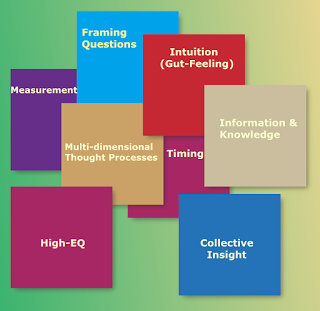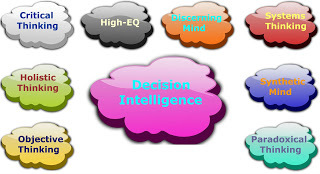Pearl Zhu's Blog, page 1256
January 28, 2017
The Best-in-Class Digital Board
 Corporate board as the top leadership team plays a significant role in business advising, leadership exemplarity, policy setting, and governance practices. How to build a best-in-class digital board? Is there any way for shareholders and key stakeholders to evaluate board leadership effectiveness?
Corporate board as the top leadership team plays a significant role in business advising, leadership exemplarity, policy setting, and governance practices. How to build a best-in-class digital board? Is there any way for shareholders and key stakeholders to evaluate board leadership effectiveness?
Think differently: Critical thinking, independent thinking, strategic thinking and innovative thinking, etc., are all important thinking capabilities for the digital BoDs because leading forward at today’s “VUCA” normality is truly not an easy task, there are many blind spots cloud the vision and there are numerous roadblocks and hidden pitfalls on the way. Hence, the board needs diversity, or even more crucially, cognitive difference, to provide a perspective that goes beyond the gaps in board discussion. Whereas what interested in the BoD is mindfulness.The different perspectives will help mitigate “groupthink” and can enable the board better relating to their stakeholders. Appreciates that the value of alternative perspectives and insights which say nothing of not trusting, simply looking from a different stance, and asking different questions. It is not as simple as looking at diversity at the skin level. From the business case standpoint, candidates from diverse groups don’t necessarily always bring the different perspective.The non-executive members should be selected for their ability to ask tough questions, share unique insight and willingness to constructively challenge management and this is less likely to happen if they are related to, or are close pals of, the executive members. They need to incorporate their unique viewpoint on people, innovation, CSR etc., into their solid knowledge of overall business and technology. Until then, they will be seen as the 'diversity' contributor- the ones who fill in the gaps via thinking differently. To put simply, the best-in-class digital board will not think the same, but thinking differently, and becomes the mastermind behind the digital transformation.
Lead innovatively: Digital is the age of innovation. No longer are boards sitting in a room and just voting on various policies, to focus on compliance only, performance is another boardroom focus for leading digital transformation. In order to build the best-in-class-digital board, the Board of directors should be proactive innovators and interactive change agents that represent the organization, stockholders, and senior management. BoDs should participate, or even lead in the area of innovation from outliers’ viewpoint. Innovation is too important to leave solely in the hands of the management team without any oversight or guidance. It is one of the requirements of the Board members to participate, or even lead, in constantly suggesting areas of innovation. Management innovation means to accelerate innovation at the multitude of levels, to create the space for dialogue and debate about why it is important for their organization, developing a common understanding of it, creating the necessity and motivation for it. The board should also ask how the enterprise measures innovations and how it compares to Best in Class performance and be sure the measurements are accurate from the eyes of the customers and their constituencies.
 Drive digital transformation relentlessly: The digital journey for organizations today is unstoppable in order to reach the vision and build the business’s long-term advantage. The business speed can only be accelerated with a clear vision, strong focus, and distinctive capabilities. The best-in-class board is further thinking with the in-depth understanding of the digital dynamic, BoDs are also in the unique position to practice out-of-thinking to bring the broader perspective to complement the management’s possible “tunnel vision.” They should set principles, develop the best and next practices, to drive digital transformation relentlessly. The intention is to enable an inclusive digital leadership culture at all levels across the organizations for clearing the path and taking a digital leap confidently.
Drive digital transformation relentlessly: The digital journey for organizations today is unstoppable in order to reach the vision and build the business’s long-term advantage. The business speed can only be accelerated with a clear vision, strong focus, and distinctive capabilities. The best-in-class board is further thinking with the in-depth understanding of the digital dynamic, BoDs are also in the unique position to practice out-of-thinking to bring the broader perspective to complement the management’s possible “tunnel vision.” They should set principles, develop the best and next practices, to drive digital transformation relentlessly. The intention is to enable an inclusive digital leadership culture at all levels across the organizations for clearing the path and taking a digital leap confidently.
The best in class board think differently and lead innovatively. The important issue is how the board accommodates diverse opinions and how they assess them and converge the diverse thought into wise decisions. The best-in-class board also practices scientific disciplines based on logic and rationalization with the artistic touch through emotion/inspiration in order to steer the enterprise ship in such a complex and ambiguous digital business dynamic to expedite changes and accelerate digital transformation.
Follow us at: @Pearl_Zhu
Published on January 28, 2017 22:53
January 27, 2017
The Monthly Insight: From Incremental Change to Quantum Leap of Digital Transformation Jan. 2017
 Change is inevitable, organizational change has become a common practice within an organization, but too often changes are made as a reaction to outer impulses, crisis, and demands. This is the bureaucracy’s way of meeting the challenges. A digital transformation is achieved via dynamic Strategy-Execution-Change life cycle management, though it is not all linear steps, but an iterative, ongoing and upgoing change continuum. How to ride ahead of the change curve and lead change effortlessly?
Change is inevitable, organizational change has become a common practice within an organization, but too often changes are made as a reaction to outer impulses, crisis, and demands. This is the bureaucracy’s way of meeting the challenges. A digital transformation is achieved via dynamic Strategy-Execution-Change life cycle management, though it is not all linear steps, but an iterative, ongoing and upgoing change continuum. How to ride ahead of the change curve and lead change effortlessly?From Incremental Change to Quantum Leap of Digital Transformation Three Principles in Managing Change Continuum? Change is a volatile subject, just like change itself. Everything changes continuously by following the laws of evolution, and the rate of change is accelerated. Organizations, like individuals, need to be in flow to operate smoothly. An organization achieves this state of equilibrium through its management practices. The strong support for continuous improvement is an essential strategy. The old stimuli of needing to change because of IT, major competitors or new market entrants are no longer the only catalysts for change. And today it is so much more about sensing emerging customers’ needs and creating new markets. The inevitable range, breadth, and pace of uncontrollable factors acting on any organizations mean constant fine tuning is essential. Change is not for its own sake, it is an ongoing business capability to execute the strategy and compete for the future. Here are three aspects of managing today’s change continuum.
Change as an Ongoing Capability? Change is a volatile subject, just like change itself. Everything changes continuously by following the laws of evolution, and the rate of change is accelerated. Corporate change can be a simple modification of strategy, a business process improvement or a more radical digital transformation. Either at the individual or organizational level, at the more static industrial era, change is a one-time project; at digital age, change has to become an ongoing capability.?
Change vs. Transformation? Change is defined in the Oxford dictionary as "substitution of one for another," and transformation is defined as "to CHANGE the character or form." Transformation....., the word itself is the first indicator, transform....The definition of transformation in the dictionary is, "to change (something) completely," so it’s much more than renewal, its rebirth. The dictionary adds..." and usually in a good way," which suggests it’s co-productive, rather than counter-productive, and implicit too, is enjoyable. Hence,it includes the affective realm of experience. It makes sense to use the complexity of the shift required to differentiate between change and transformation. The biggest challenge with any large scale transformation program is – do the senior leaders truly understand the time and impact on the organization and do they have the intestinal fortitude to hold up to corrections in the face of quarterly earnings report pressure? In that light, isn't the point of the discussion here to clarify something about management? What is difficult about the concept of managing one or more changes as a means of accomplishing a managed transformation?
Change Management in Digital Transformation: Almost all of the forward-thinking organizations are at the journey of digital transformation. Digital means the increasing speed of changes, hyperconnectivity, and always-on businesses. And digital transformation is the leapfrogging from the accumulated changes, so how to manage changes more effectively? Anyone repeating the 70% failure rate for change programs should immediately arouse some suspicion. This would indicate that for nearly 20 years managers have been condoning and embarking on something which is known to fail 70% of the time. Would we really have accepted such incompetence over such a long period?
 Three Aspects of Business Transformation? There are too many organizations with transformation programs that are not driven by strategy. So they end up being silo transformations with no systems thinking applied. How to manage a successful business transformation, such as digitalization or globalization, here are three aspects.
Three Aspects of Business Transformation? There are too many organizations with transformation programs that are not driven by strategy. So they end up being silo transformations with no systems thinking applied. How to manage a successful business transformation, such as digitalization or globalization, here are three aspects.Blogging is not about writing, but about thinking; it’s not just about WHAT to say, but about WHY to say, and HOW to say it. It reflects the color and shade of your thought patterns, and it indicates the peaks and curves of your thinking waves. Unlike pure entertainment, quality and professional content takes time for digesting, contemplation and engaging, and therefore, it takes the time to attract the "hungry minds" and the "deep souls." It’s the journey to amplify your voice, deepen your digital footprints, and match your way for human progression.
Follow us at: @Pearl_Zhu
Published on January 27, 2017 23:06
The 2017 Lunar New Year Celebration: The Facts and Data of Spring Festival
 The 2017 lunar New Year is around the corner. The lunar new year celebration is a festival for ⅕ of the world’s population. The lunar New Year has been celebrated for more than 4000 years, it symbolizes the end of winter and the beginning of spring, thus, it’s also be called the Spring Festival, it was also a festival to honor ancestors as well as other holy beings. Here are some interesting facts and data about lunar new year.
The 2017 lunar New Year is around the corner. The lunar new year celebration is a festival for ⅕ of the world’s population. The lunar New Year has been celebrated for more than 4000 years, it symbolizes the end of winter and the beginning of spring, thus, it’s also be called the Spring Festival, it was also a festival to honor ancestors as well as other holy beings. Here are some interesting facts and data about lunar new year.
The lunar New Year lands on the first day of the lunar month and continues for 15 days, until the moon is full, Each of the 15 days of the celebrations has a particular role.
Each year of the lunar 12-year cycle is named after an animal. Once the 12-year cycle is over, the animal list begins again. The 12 animals are rat, ox, tiger, rabbit, dragon, snake, horse, sheep, monkey, rooster, dog, and pig.
The two popular flowers most commonly associated with Spring festival are the plum blossom and water narcissus. The plum blossom is the symbol of courage and hope; and the water narcissus is symbolized good luck, and prosperity. Vases of flowers are placed around houses to symbolize rebirth and growth. Bowls of oranges and tangerines are also displayed to symbolize good luck and wealth.
The dragon dances and street fairs are popular holiday events as well. Dancers dress up as lions and dragons and perform for onlookers. It is for good luck and it is believed that the lion is an auspicious animal.
 The New Year Wishes are full of good and lucky words, the “unlucky,” negative words or foul language are discouraged. Only talking about the past is also discouraged because everything should be turned to the future new year and new beginnings.
The New Year Wishes are full of good and lucky words, the “unlucky,” negative words or foul language are discouraged. Only talking about the past is also discouraged because everything should be turned to the future new year and new beginnings.
The lunar New Year ends with the lantern festival, which takes place on the 15th (last day) of the celebration. Families gather for dinner and go out and see fireworks and light lanterns Lanterns are put up for decoration, let loose to fly, and floated in rivers. The lanterns are believed to light the way for the new year. Firework display during the Lunar New Year stem from the tradition of lighting bamboo stalks. There are all the symbols of the light to shine up the upcoming new year with new perspective.
It is the other time for self-reflection, recharging and making resolution. Wish all of us to have a prosperous and peaceful Year of the Rooster.
Follow us at: @Pearl_Zhu
Published on January 27, 2017 23:01
“Decision Master” Book Introduction Chapter 2: Decision-Making Principles
 Digital is about the increasing pace of changes and overwhelming information. One significant effect of digitization is increased velocity, complexity, ambiguity, unpredictability, and a need for a faster response to changes in businesses and industries based on effective and efficient decision making. Decision making is both art and science, making either strategic or tactical decision effectively is one of the most critical responsibilities facing them every day. How to set principles and guidelines for reaching the high level of decision maturity in your organization?
Digital is about the increasing pace of changes and overwhelming information. One significant effect of digitization is increased velocity, complexity, ambiguity, unpredictability, and a need for a faster response to changes in businesses and industries based on effective and efficient decision making. Decision making is both art and science, making either strategic or tactical decision effectively is one of the most critical responsibilities facing them every day. How to set principles and guidelines for reaching the high level of decision maturity in your organization?
Part of problem for decision-making has to do with how you frame the question: Inappropriate framing is being the root cause of most bad decisions. Often time people rush up to make decisions or jump to a conclusion even without understanding the real issues. Many times, framing the right question is one of the most crucial step in decision-making. It’s the step decision makers can slow down and think through the implication of their subjective assumptions. This is particularly important for strategic decision-making. The approach is to offer people a consistent process that enables them to access relevant information to inform the decision, weigh up the alternatives, and develop the insights that guide their final decisions. So, the great leaders are surrounding themselves with people who can contribute to framing the decision, and then procure the resources for that decision to be enacted.
You have to be selective for getting the right information and capturing the valuable insight in making decisions: Decision is about future, and future is full of uncertainty. Information and decision-making are intimately connected and interdependent. The information allows you to build an actionable insight on how to move from one level to the other. Information as input to the decision-making does not absolutely determine the decision but allows the decision-maker to exercise their judgment. It applies to the context and environment in which decisions are made. For decision-making to be effective, the decision-maker must have enough knowledge to make their decisions rich in information and significantly different from the available data. Because how effective the decision in depends on how capable the decision maker can climb the knowledge pyramid from data to information to insight and wisdom.
 Making timely decisions: As old saying goes: A wrong decision taken at the right time is better than a right decision taken at the wrong time. Timing is always critical for decision-making effectiveness. Each decision is subject to the conditions under which it was taken via the requirements of the person taking the decision. You do not and can’t afford to defer the decision until such time that all facts and information are available. Decision are necessary as a result of limited resources in time, knowledge, capital, and people. Behind every decision, there is always an element of uncertainty and doubt. It is up to the decision-maker how he or she handles it. But significantly, decisions are to be made on time, and this is more imperative when uncertainty and doubts are major hindrances to decision making. No decision in the world outlives the time, place, and the person’s constituents on basis of which it was made.
Making timely decisions: As old saying goes: A wrong decision taken at the right time is better than a right decision taken at the wrong time. Timing is always critical for decision-making effectiveness. Each decision is subject to the conditions under which it was taken via the requirements of the person taking the decision. You do not and can’t afford to defer the decision until such time that all facts and information are available. Decision are necessary as a result of limited resources in time, knowledge, capital, and people. Behind every decision, there is always an element of uncertainty and doubt. It is up to the decision-maker how he or she handles it. But significantly, decisions are to be made on time, and this is more imperative when uncertainty and doubts are major hindrances to decision making. No decision in the world outlives the time, place, and the person’s constituents on basis of which it was made.Digital maturity is to ensure that the right decisions have been made by the right people at the right time. Ultimately, you should remember each decision is subject to the conditions under which it was taken. It is important for setting principles to make an assessment of decision-making scenario and developing the frameworks and practices to improve decision maturity. Follow us at: @Pearl_Zhu
Published on January 27, 2017 22:59
CIOs as Chief Intrapreneur Officer: How to Encourage Creativity and Manage Innovation
 It's common that many IT companies tend to focus more on their core competencies with age and often forget about the value of innovation. Without encouraging creativity, organizations would be upstaged by the ones that are creative because disruptive innovation will happen no matter how well you prepare. Digital IT needs to be run as a business, and digital CIOs should be the “Chief Intrapreneur Officer,” with “whole brain” thinking: Being logic in your mind based on your years of engineering training and experiences and be creative in your heart, dream big and think big. Because the CIO’s vision will directly impact their organization’s strategic perspective for the long term. So, how to encourage creativity and manage innovation effectively?
It's common that many IT companies tend to focus more on their core competencies with age and often forget about the value of innovation. Without encouraging creativity, organizations would be upstaged by the ones that are creative because disruptive innovation will happen no matter how well you prepare. Digital IT needs to be run as a business, and digital CIOs should be the “Chief Intrapreneur Officer,” with “whole brain” thinking: Being logic in your mind based on your years of engineering training and experiences and be creative in your heart, dream big and think big. Because the CIO’s vision will directly impact their organization’s strategic perspective for the long term. So, how to encourage creativity and manage innovation effectively?
IT plays a threshold competency role in building the culture of innovation: Many times, the innovators think they live in the idea wonderland, but in reality, they get trapped in the primitive tropical forest fighting negative competitions. Nowadays even people use the variety of cool and advanced gadgets, but many mindsets are so outdated, far, far behind the digital era we live in. Hence, IT shouldn’t just provide the cool gadgets and expect the new ideas will start flowing; it is more critical to build a healthy culture to encourage learning and creativity. Being innovative is truly a state of mind. Unfortunately, it seems creativity is not encouraged in most organizations. If CIOs don't soon realize that stifling the creative mind of IT will set back business, their IT organizations would continue to be perceived as a cost center. It is important for IT leaders to motivate teams to cultivate change capabilities, encourage subordinates to think out of the box and bring back new designs that they might not even recognize using the current context.
Identify the great innovators and change agents who can think ahead, think big and think differently: An innovator is often a visionary and a pathfinder. The new way to do things. Being creative means you need to get used to stepping outside the old box to unfamiliar territory, you discover and explore your own path. Innovators find more viewing spots than the rest. They find angles to wiggle through where most are unable to even envision a place where there is an angle. The have the ability to connect the unusual dots and see things via the broader lens. The world needs more of creative thinkers who can handle the ever increasing complexities and discover the new path for leading digital transformation. Nowadays, IT is often the disruptive force of business transformation, therefore, IT talent should use the creative side to create new ways of doing things that allow for innovation to happen. If you weren't able to think creatively in IT, you would be disrupted and floundering as much as those falling mighty.
 Practicing intrapreneurship in IT is to run IT as business and “Do more with innovation”: Creativity is the core of what makes IT strategic in any company, but it is critical that the creativity is focused not on the technology but on how it can be used to advance the business objectives. Creativity without a direction or purpose is building technology for the technology’s sake. IT creativity is struggling to occur and it is the reason many executives believe IT is not business aligned. Good intrapreneur-leaders explain the big “whys” clearly, to articulate the strategic rationale behind the venture, as more often than not, intrapreneurship is about discovering the new path for digital transformation and balancing innovation with other organizational priorities. In fact, creativity and process have to go hand in hand. Practicing intrapreneurship in large enterprises needs to strike the right balance between stability and agility, process and creativity.
Practicing intrapreneurship in IT is to run IT as business and “Do more with innovation”: Creativity is the core of what makes IT strategic in any company, but it is critical that the creativity is focused not on the technology but on how it can be used to advance the business objectives. Creativity without a direction or purpose is building technology for the technology’s sake. IT creativity is struggling to occur and it is the reason many executives believe IT is not business aligned. Good intrapreneur-leaders explain the big “whys” clearly, to articulate the strategic rationale behind the venture, as more often than not, intrapreneurship is about discovering the new path for digital transformation and balancing innovation with other organizational priorities. In fact, creativity and process have to go hand in hand. Practicing intrapreneurship in large enterprises needs to strike the right balance between stability and agility, process and creativity.
The art of innovation is that it involves new ways of bringing together ideas and resources to create something novel. The science of innovation is to take a structural approach to innovation management. IT is an innovation engine of any business in the digital era, to equip people with the latest technology and information, to help the business make the right decision at every level, to capture insight and foresight for the future of the organization. Digital CIOs shouldn't classify creativity and logic as two completely different disciplines, they are inter-connected, only mixing them seamlessly, CIOs can manage innovation effectively.
Follow us at: @Pearl_Zhu
Published on January 27, 2017 22:55
January 26, 2017
The Weekly Insight of the “Future of CIO” 1/28/ 2017
 The “Future of CIO” Blog has reached 1.7 million page views with 3300+ blog posting in 59+ different categories of leadership, management, strategy, digitalization, change/talent, etc. The content richness is not for its own sake, but to convey the vision and share the wisdom. Here is the weekly insight about digital leadership, IT Management, and Talent Management.
The “Future of CIO” Blog has reached 1.7 million page views with 3300+ blog posting in 59+ different categories of leadership, management, strategy, digitalization, change/talent, etc. The content richness is not for its own sake, but to convey the vision and share the wisdom. Here is the weekly insight about digital leadership, IT Management, and Talent Management.
The Weekly Insight of the “Future of CIO” 1/28/2017Three “Don’t” in IT Digital Transformation: With the increasing pace of change and overwhelming growth of information, the IT role is becoming far more than simply keeping the lights on, but is transforming to significant business enablement and catalyzer. As the CIO continues to become a more critical and integral member of the C-suite, IT leadership holds the keys to making the company more efficient and effective, implement processes and build capabilities that drive the company to the next level; keep eyes on what happens today, pay more attention to the potential pitfalls, also be focused on what is next. Here are three “Don’ts” in IT digital transformation.
Conformance vs. Performance: What’s Board’s Priority Corporate Board is one of the most important governance bodies to oversight strategy and enforce GRC disciplines. Many directors think that the role of the director is conformance. The underlying question is actually fundamental: What is corporate governance, when is it necessary and how should it work? Conformance vs. Performance, which is more important for the Corporate Board? Is it possible that companies are burdening the boards with so many different tasks that the main task and focus of the board, which is to create long-term profitable companies, will be inundated by all other types of issues?
Digital CIO’s Mindset, Skillset, and Toolset: The CIO role is perhaps one of the most sophisticated executive positions in modern businesses because they have to wear multiple personas and adapt to changes all the time, due to the exponential growth of information and change nature of technologies. They need to be both business strategists and hands-on managers; advocate innovation and set policies; drive changes and manage risks, etc. Overall speaking, CIOs are the leadership role, not only do they need qualities and skills to transform their IT organization, more importantly, they should have altitude, aptitude, and attitude to be the influencers, change agents, and talent masters in the enterprise and its expanding business ecosystem; and they should get mindset, skillset and toolset ready for driving changes and leading digital transformation effortlessly. The New Book “Decision Master-The Art and Science of Decision Making” Introduction Both businesses and the world become over-complex, hyper-connected, extremely uncertain and ambiguous than ever, making effective decisions is both art and science. There are blind spots block the vision and there are pitfalls on the way. Decision Masters refer to the digital leaders or professionals who can leverage multidimensional thought processes, information and intuition, take a step-wise scenario for making effective decisions consistently. Decision Masters also refer to the businesses or organizations that follow a set of well-defined principles, leverage fine-tuned decision processes, efficient information management system, decision frameworks, tools, and metrics to enable people across the organization making effective decisions collaboratively. Decision-making is both art and science. More specifically, what are the digital philosophy, principles, and practices to improve decision-making effectiveness and increase the overall business responsiveness and maturity?
 Making IT Assessment for Leading Digital Transformation Due to increasing speed of changes and exponential growth of information, more often than not, technology is the driver of business changes or the accelerator of the digital transformation. How can IT shift from a back office support function to the digital brain yard and forerunner? How should IT leaders and managers make an objective and comprehensive IT management assessment in order to lead changes and digital transformation effortlessly?
Making IT Assessment for Leading Digital Transformation Due to increasing speed of changes and exponential growth of information, more often than not, technology is the driver of business changes or the accelerator of the digital transformation. How can IT shift from a back office support function to the digital brain yard and forerunner? How should IT leaders and managers make an objective and comprehensive IT management assessment in order to lead changes and digital transformation effortlessly?
Blogging is not about writing, but about thinking and innovating the new ideas; it’s not just about WHAT to say, but about WHY to say, and HOW to say it. It reflects the color and shade of your thought patterns, and it indicates the peaks and curves of your thinking waves. Unlike pure entertainment, quality and professional content takes time for digesting, contemplation and engaging, and therefore, it takes the time to attract the "hungry minds" and the "deep souls." It’s the journey to amplify diverse voices and deepen digital footprints, and it's the way to harness your innovative spirit.
Follow us at: @Pearl_Zhu
Published on January 26, 2017 23:02
The New Book “Decision Master” Introduction Chapter 1 Decision Intelligence
 Intelligence is the word we use to describe mental ability. Intelligence is the capacity to understand and apply wisdom to the knowledge you are exposed to. Out intelligence with regard to any given type of information is a function of our capacity to recognize and interpret patterns, and our consequent ability to use the perceived information for making sound judgments or effective decisions. High mental ability is important to make effective decisions.
Intelligence is the word we use to describe mental ability. Intelligence is the capacity to understand and apply wisdom to the knowledge you are exposed to. Out intelligence with regard to any given type of information is a function of our capacity to recognize and interpret patterns, and our consequent ability to use the perceived information for making sound judgments or effective decisions. High mental ability is important to make effective decisions.
The real critical thinkers are good decision makers: Critical thinking has been described as “thinking about thinking.” Critical thinking is the intellectually disciplined process of actively and skillfully conceptualizing, applying, analyzing, synthesizing, and evaluating information in order to make effective decisions. Only very small percentage of the population are truly critical thinkers. Most decisions on problem-solving are based on “logic” which is a key component of the process of critical thinking generally. Critical thinking as an iterative thought process leads to a series of refinements based on learning and experience. In the business world, at least, you can’t always wait for the “best” decision to emerge. You have to make the best decision you can, based on a sound process and have the gut to admit when a mid-course correction is in order. Critical thinking is crucial for making decisions and dealing with uncertainty and complexity of today’s digital dynamic; it also helps to challenge the conventional wisdom, identify gaps, able to imagine or remain open to considering alternative solutions.
High EQ is crucial in making fair judgments or sound decisions: Emotional Quotient is its simplest form is being aware of our emotions and managing them to get best out of the situation. EQ becomes even more crucial for making effective decisions and leading today’s business dynamic with uncertainty, ambiguity, and complexity. High EQ helps you have an open mind, minimize biases, be cautiously optimistic, be an effective listener and be more creative. High EQ is important in making sound judgments, strategic decisions, and driving the organization’s long-term success. IQ is about the ability to reasoning and cognitive skills which are important for the digital knowledge workers today, but EQ plays a crucial role in managing emotions and avoiding many thinking pitfalls such as bias, extreme thinking, hubris, negativity, etc. A well-blended high “IQ+EQ” digital mind can mix the brainpower and emotional power in making sound decisions.
 A synthetic mind to improve decision maturity: Decision-making is an analytics-synthesis continuum. Analysis is about understanding the thing by examining it as parts. Synthesis is about understanding a thing by examining it as a whole. Either for making decisions or solving problems, in any case, analysis is necessary to have knowledge of an argument, a situation, a problem. Synthesis is necessary to summarize understanding of it and to transfer information about it to others without “lost in translation.” They are the two ends of the line between understanding the parts and understanding the whole., very different, but also equally and inextricably linked to the process of understanding the problems. They are invaluable intellectual processes for decision-making.
A synthetic mind to improve decision maturity: Decision-making is an analytics-synthesis continuum. Analysis is about understanding the thing by examining it as parts. Synthesis is about understanding a thing by examining it as a whole. Either for making decisions or solving problems, in any case, analysis is necessary to have knowledge of an argument, a situation, a problem. Synthesis is necessary to summarize understanding of it and to transfer information about it to others without “lost in translation.” They are the two ends of the line between understanding the parts and understanding the whole., very different, but also equally and inextricably linked to the process of understanding the problems. They are invaluable intellectual processes for decision-making. Either for individuals or businesses, contemporary intelligence for decision-making is contextual and multidimensional. IT is not just about IQ or EQ, there are strategic intelligence, creative intelligence, system intelligence, judgmental intelligence, paradoxical intelligence, social intelligence, etc. Digital leaders and professionals must keep learning to sharpen multidimensional intelligence for making sound judgments and effective decisions cohesively.Follow us at: @Pearl_Zhu
Published on January 26, 2017 22:54
An Accelerator Digital Board
 Corporate Board plays a significant role in overseeing organizational strategy, setting policies, practicing governance and exemplifying leadership disciplines. The board also has to strike the right balance between acceleration and governance. The board with digital savvy BoDs understand what's required and how as a high-level basis of going digital mean to the business, so they can make a significant impact on accelerating digital transformation with a premium speed.
Corporate Board plays a significant role in overseeing organizational strategy, setting policies, practicing governance and exemplifying leadership disciplines. The board also has to strike the right balance between acceleration and governance. The board with digital savvy BoDs understand what's required and how as a high-level basis of going digital mean to the business, so they can make a significant impact on accelerating digital transformation with a premium speed.
The accelerated mindset: The corporate board as a top leadership team plays a significant role in steering the business to the right direction; at today’s “VUCA” digital new normal, it is not an easy task, BoDs need to have learning agility for updating knowledge, enjoying fresh point of view, and abstracting knowledge to insight to wisdom. With the fast pace of changes, the most important function of any board is the oversight of a holistic company strategy and execution through focused leadership, monitor its implementation and results, amend wherever necessary to match changing marketplace conditions. Hence, an accelerator board can ride above the learning curve quickly via staying focus, setting discipline, and strengthening the strength, these BoDs can also exemplify accelerated leadership - authentic, innovative, audacious, adaptive for driving changes seamlessly. The BoDs with accelerated mindset can solve critical business problems more creatively, and practice digital leadership with vision and passion.
Accelerating performance: The boards have to both oversee strategy management as well as practice governance disciplines. BoDs need to strike the right balance between performance and compliance. That means they have to show the organization is “playing to win,” not just trying not to lose - with accelerating performance. More specifically, the board’s role, in large part is to make good decisions that enhance the value creation for the organization. They need to focus on their own performance as well as the performance of the management team. Perhaps one of the dilemmas of the modern board is that at one time, they need to push the gas pedal to accelerate the business speed; at the other time, they will be the brake for practicing governance discipline. Still, it is not about stopping the corporate vehicle, but ensure it’s running at a premium speed, that organization produces a worthwhile pattern of good results while avoiding an undesirable pattern of bad circumstance. It is running at a steadfast pace, out beat competitions, still full of energy.
 Accelerating digital transformation: Organizations large or small are on the journey of digital transformation, speed matters because it reflects the organizational change capability and directly impacts the responsiveness of the business and effectiveness of strategy management. The Board provides an “outside-in” view of businesses and multi-dimensional lenses to oversee and advise business strategy and execution. To accelerate such a business transformation, BoDs start with big and compelling reason WHY - to clear the vision and fuel the passion. When the WHY gets clarified, get into the WHAT - not about micromanagement, but about clarifying responsibility and accountability. And then touch the significant part of HOW - not about trivial details, but for deepening understanding. If needed, also follow up with WHO: Who is accountable for a vision for the change? Who is initiating the change? Who is providing change adoption strategy? Who leads the execution of change? Ask ‘CORE’ questions in terms of accountability when talking about a digital transformation, it can impact the core, enabling and supporting capabilities of the business. You need to understand that if talking about business at core enabling and supporting level, in that case, accountability comes from managers at core.
Accelerating digital transformation: Organizations large or small are on the journey of digital transformation, speed matters because it reflects the organizational change capability and directly impacts the responsiveness of the business and effectiveness of strategy management. The Board provides an “outside-in” view of businesses and multi-dimensional lenses to oversee and advise business strategy and execution. To accelerate such a business transformation, BoDs start with big and compelling reason WHY - to clear the vision and fuel the passion. When the WHY gets clarified, get into the WHAT - not about micromanagement, but about clarifying responsibility and accountability. And then touch the significant part of HOW - not about trivial details, but for deepening understanding. If needed, also follow up with WHO: Who is accountable for a vision for the change? Who is initiating the change? Who is providing change adoption strategy? Who leads the execution of change? Ask ‘CORE’ questions in terms of accountability when talking about a digital transformation, it can impact the core, enabling and supporting capabilities of the business. You need to understand that if talking about business at core enabling and supporting level, in that case, accountability comes from managers at core.
An accelerator board with digital-savvy BoDs equipped with growth mindset has the advantage of pulling enough resources and pushing the business model of technology, trustworthiness to accelerate performance; prepare and launch change, innovate, and master digital fluency to make a leap of digital transformation.
Follow us at: @Pearl_Zhu
Published on January 26, 2017 22:51
January 25, 2017
CIOs as “Chief Inquisitive Officer: A set of Q&As for IT Reinventing & Brainding
We live in a hyper-connected digital world, every day the abundant information and more and more technologies affect the way we live, learn, think, and interact.
 Modern CIOs face many challenges, it is not sufficient to only keep the lights on. Regardless of which industry or the nature of organization you are in, being a digital leader will need to master the art of creating unique, differentiating value from piles of commoditized technologies and take advantage of the emergent digital trends as well; digital CIOs also have multiple personas, “Chief Innovation Officer,” “Chief Insight Officer,” “Chief Improvement Officer,” “Chief Information Officer,” and here, we discuss CIOs as “Chief Inquisitive Officer,” with a set of Q&As to lead digital transformation.
Modern CIOs face many challenges, it is not sufficient to only keep the lights on. Regardless of which industry or the nature of organization you are in, being a digital leader will need to master the art of creating unique, differentiating value from piles of commoditized technologies and take advantage of the emergent digital trends as well; digital CIOs also have multiple personas, “Chief Innovation Officer,” “Chief Insight Officer,” “Chief Improvement Officer,” “Chief Information Officer,” and here, we discuss CIOs as “Chief Inquisitive Officer,” with a set of Q&As to lead digital transformation.
Why IT Doesn’t Get Respected? IT seems to be always at the paradoxical position, on one hand, technology is omnipresent, touch every corner of enterprise, on the other hand, many IT organizations earn very little respect from business peers, why, and how to turn around?
The Art of Possible: How to Shift from Transactional IT to Transformational IT Even though IT permeates to almost every corner of the business, many traditional IT organizations are still perceived as an invisible back office maintenance function, without sufficient knowledge about the business model of the organization. Although technology is often the disruptive force behind changes and digital transformation, most IT organizations get stuck at the lower level of maturity, running as a reactive service provider. CIOs as business strategists: How to pursue the art of possible - make a shift from a mechanical IT to innovative IT? From reactive IT to accelerating IT? And from transactional IT to transformational IT?
Is IT organization perceived as confident or Arrogant? On one side, IT complains not getting respected from the business; on the other side, business think IT acts arrogant sometimes; such “he said, she said,” “Pride & Prejudice” dilemmas continue to stir up new debate in CIO forums, the point is not to figure out who is right and who is wrong, the key is how IT can leverage different viewpoint and keep improving leadership and service. But, how to adjust the attitude or break down the bias?
What are Characteristics of High-Mature IT? We live in a hyper-connected digital world, every day the abundant information and more and more technologies affect the way we live, learn, think, and interact. Great opportunity, danger, digital convenience, and disruption are around every corner. Hence, IT organizations play a more crucial role in accelerating changes and catalyze innovation. Therefore, ensuring a high-performing, high-reliable and high-proactive IT is the key success factor in organizational digital transformation. Here are three characteristics of high mature IT organization.
 How to Run a Multi-Dimensional IT Organization? IT suffered from its reputation as a cost center at the industrial age, IT leaders need to look harder upon their organizations through multi-dimensional lenses, how to generate business value from IT, and continue to ask those tough questions: Are we doing the right things? – Planning; Are we doing them the right way - Processes, People; Are we getting them done well - Evaluation or Are we getting the benefits? – ROI.
How to Run a Multi-Dimensional IT Organization? IT suffered from its reputation as a cost center at the industrial age, IT leaders need to look harder upon their organizations through multi-dimensional lenses, how to generate business value from IT, and continue to ask those tough questions: Are we doing the right things? – Planning; Are we doing them the right way - Processes, People; Are we getting them done well - Evaluation or Are we getting the benefits? – ROI.
The digital CIOs need to reimagine IT as the business growth engine and lead changes via inquiries. They need to keep asking open-ended questions such as, "Why? Why not? What If?" They have to focus on guiding the company through the digital transformation, and create unique business value because IT is the significant element of any differentiated business capability and the defining factor for competitive advantage.
Follow us at: @Pearl_Zhu
 Modern CIOs face many challenges, it is not sufficient to only keep the lights on. Regardless of which industry or the nature of organization you are in, being a digital leader will need to master the art of creating unique, differentiating value from piles of commoditized technologies and take advantage of the emergent digital trends as well; digital CIOs also have multiple personas, “Chief Innovation Officer,” “Chief Insight Officer,” “Chief Improvement Officer,” “Chief Information Officer,” and here, we discuss CIOs as “Chief Inquisitive Officer,” with a set of Q&As to lead digital transformation.
Modern CIOs face many challenges, it is not sufficient to only keep the lights on. Regardless of which industry or the nature of organization you are in, being a digital leader will need to master the art of creating unique, differentiating value from piles of commoditized technologies and take advantage of the emergent digital trends as well; digital CIOs also have multiple personas, “Chief Innovation Officer,” “Chief Insight Officer,” “Chief Improvement Officer,” “Chief Information Officer,” and here, we discuss CIOs as “Chief Inquisitive Officer,” with a set of Q&As to lead digital transformation.
Why IT Doesn’t Get Respected? IT seems to be always at the paradoxical position, on one hand, technology is omnipresent, touch every corner of enterprise, on the other hand, many IT organizations earn very little respect from business peers, why, and how to turn around?
The Art of Possible: How to Shift from Transactional IT to Transformational IT Even though IT permeates to almost every corner of the business, many traditional IT organizations are still perceived as an invisible back office maintenance function, without sufficient knowledge about the business model of the organization. Although technology is often the disruptive force behind changes and digital transformation, most IT organizations get stuck at the lower level of maturity, running as a reactive service provider. CIOs as business strategists: How to pursue the art of possible - make a shift from a mechanical IT to innovative IT? From reactive IT to accelerating IT? And from transactional IT to transformational IT?
Is IT organization perceived as confident or Arrogant? On one side, IT complains not getting respected from the business; on the other side, business think IT acts arrogant sometimes; such “he said, she said,” “Pride & Prejudice” dilemmas continue to stir up new debate in CIO forums, the point is not to figure out who is right and who is wrong, the key is how IT can leverage different viewpoint and keep improving leadership and service. But, how to adjust the attitude or break down the bias?
What are Characteristics of High-Mature IT? We live in a hyper-connected digital world, every day the abundant information and more and more technologies affect the way we live, learn, think, and interact. Great opportunity, danger, digital convenience, and disruption are around every corner. Hence, IT organizations play a more crucial role in accelerating changes and catalyze innovation. Therefore, ensuring a high-performing, high-reliable and high-proactive IT is the key success factor in organizational digital transformation. Here are three characteristics of high mature IT organization.
 How to Run a Multi-Dimensional IT Organization? IT suffered from its reputation as a cost center at the industrial age, IT leaders need to look harder upon their organizations through multi-dimensional lenses, how to generate business value from IT, and continue to ask those tough questions: Are we doing the right things? – Planning; Are we doing them the right way - Processes, People; Are we getting them done well - Evaluation or Are we getting the benefits? – ROI.
How to Run a Multi-Dimensional IT Organization? IT suffered from its reputation as a cost center at the industrial age, IT leaders need to look harder upon their organizations through multi-dimensional lenses, how to generate business value from IT, and continue to ask those tough questions: Are we doing the right things? – Planning; Are we doing them the right way - Processes, People; Are we getting them done well - Evaluation or Are we getting the benefits? – ROI.
The digital CIOs need to reimagine IT as the business growth engine and lead changes via inquiries. They need to keep asking open-ended questions such as, "Why? Why not? What If?" They have to focus on guiding the company through the digital transformation, and create unique business value because IT is the significant element of any differentiated business capability and the defining factor for competitive advantage.
Follow us at: @Pearl_Zhu
Published on January 25, 2017 22:03
CIOs as “Chief Inquisitive Officer: A set of Q&As for IT Reinventing
 Modern CIOs face many challenges, it is not sufficient to only keep the lights on. Regardless of which industry or the nature of organization you are in, being a digital leader will need to master the art of creating unique, differentiating value from piles of commoditized technologies and take advantage of the emergent digital trend as well; digital CIOs also have multiple personas, “Chief Innovation Officer,” “Chief Insight Officer,” “Chief Improvement Officer,” “Chief Information Officer,” and here, we discuss CIOs as “Chief Inquisitive Officer,” with a set of Q&As to lead digital transformation.
Modern CIOs face many challenges, it is not sufficient to only keep the lights on. Regardless of which industry or the nature of organization you are in, being a digital leader will need to master the art of creating unique, differentiating value from piles of commoditized technologies and take advantage of the emergent digital trend as well; digital CIOs also have multiple personas, “Chief Innovation Officer,” “Chief Insight Officer,” “Chief Improvement Officer,” “Chief Information Officer,” and here, we discuss CIOs as “Chief Inquisitive Officer,” with a set of Q&As to lead digital transformation.
Why IT Doesn’t Get Respected? IT seems to be always at the paradoxical position, on one hand, technology is omnipresent, touch every corner of enterprise, on the other hand, many IT organizations earn very little respect from business peers, why, and how to turn around?
The Art of Possible: How to Shift from Transactional IT to Transformational IT Even though IT permeates to almost every corner of the business, many traditional IT organizations are still perceived as an invisible back office maintenance function, without sufficient knowledge about the business model of the organization. Although technology is often the disruptive force behind changes and digital transformation, most IT organizations get stuck at the lower level of maturity, running as a reactive service provider. CIOs as business strategists: How to pursue the art of possible - Make a shift from a mechanical IT to innovative IT? From a reactive IT to accelerating IT? And from transactional IT to transformational IT?
Is IT organization perceived as confident or Arrogant? On one side, IT complains not getting respected from the business; on the other side, business think IT acts arrogant sometimes; such “he said, she said”, “Pride & Prejudice” dilemmas continue to stir up new debate in CIO forums, the point is not to figure out who is right and who is wrong, the key is how IT can leverage different viewpoint and keep improving leadership and service. But, how to adjust the attitude or break down the bias?
What are Characteristics of High-Mature IT? We live in a hyper-connected digital world, every day the abundant information and more and more technologies affect the way we live, learn, think, and interact. Great opportunity, danger, digital convenience, and disruption are around every corner. Hence, IT organizations play a more crucial role in accelerating changes and catalyze innovation. Therefore, ensuring a high-performing, high-reliable and high-proactive IT is the key success factor in organizational digital transformation. Here are three characteristics of high mature IT organization.
 How to Run a Multi-Dimensional IT Organization? IT suffered from its reputation as a cost center at industrial age, IT leaders need to look harder upon their organizations through multi-dimensional lenses, how to generate business value from IT, and continue to ask those tough questions: Are we doing the right things? – Planning; Are we doing them the right way - Processes, People; Are we getting them done well - Evaluation or Are we getting the benefits? – ROI. Below are five dimensions to look at IT both strategically and tactically, and how to unleash its full potential at the digital era.
How to Run a Multi-Dimensional IT Organization? IT suffered from its reputation as a cost center at industrial age, IT leaders need to look harder upon their organizations through multi-dimensional lenses, how to generate business value from IT, and continue to ask those tough questions: Are we doing the right things? – Planning; Are we doing them the right way - Processes, People; Are we getting them done well - Evaluation or Are we getting the benefits? – ROI. Below are five dimensions to look at IT both strategically and tactically, and how to unleash its full potential at the digital era.
The digital CIOs need to reimagine IT as the business growth engine and lead changes via inquiries. They need to keep asking open-ended questions such as, "Why? Why not? What If?" They have to focus on guiding the company through the digital transformation, and create unique business value because IT is the significant element of any differentiated business capability and the defining factor for competitive advantage.
Follow us at: @Pearl_Zhu
Published on January 25, 2017 22:03



